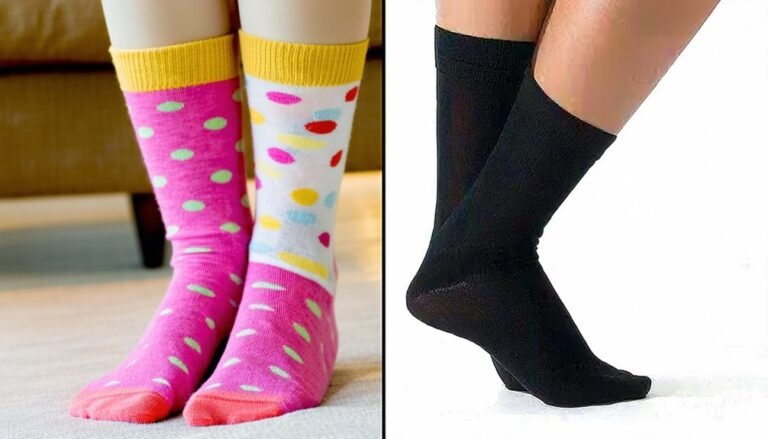Compression Socks 15-20 Vs 20-30
When deciding between 15-20 mmHg and 20-30 mmHg compression socks, consider your specific needs. The 15-20 mmHg level effectively enhances circulation and reduces minor swelling, making it ideal for daily use and travel. In contrast, 20-30 mmHg supports more severe venous issues like chronic insufficiency and significant edema. Always consult with a healthcare professional for the most suitable choice. Understanding these differences will guarantee the best therapeutic outcomes for your leg health.
Understanding Compression Levels

When it comes to compression socks, understanding compression levels is essential for optimizing therapeutic benefits and ensuring comfort. Different pressure types are designed to meet specific medical needs. Compression levels are measured in millimeters of mercury (mmHg), indicating the pressure applied to your legs. Choosing the right level is vital for safety and efficacy. Lower compression, such as 15-20 mmHg, provides mild pressure types suitable for maintaining leg health and preventing minor swelling. Conversely, higher compression levels, like 20-30 mmHg, offer moderate pressure for managing more severe conditions like varicose veins or deep vein thrombosis. It's imperative to consult with a healthcare provider to determine the appropriate compression level for your individual health needs, enhancing safety and therapeutic outcomes.
Benefits of 15-20 Mmhg Compression Socks
For individuals seeking to enhance circulation and reduce minor leg swelling, 15-20 mmHg compression socks offer a practical solution. These socks provide moderate pressure, which can effectively support venous return and decrease the risk of venous insufficiency. The health benefits are significant, especially for daily use. By consistently wearing these socks, you can experience improved blood flow, potentially reducing discomfort and fatigue associated with prolonged standing or sitting.
Designed for safety and comfort, 15-20 mmHg compression socks are ideal for those with mild symptoms or preventative needs. They're often recommended for travel, pregnancy, or occupations requiring extended periods of immobility. You'll find that these socks offer a non-invasive method to promote vascular health, contributing to your overall well-being without compromising safety.
Advantages of 20-30 Mmhg Compression Socks
Although 15-20 mmHg compression socks are suitable for mild symptoms, 20-30 mmHg compression socks offer a higher level of support, making them ideal for more pronounced venous issues. This increased compression aids in significant swelling reduction, enhancing venous return and reducing discomfort in your legs. For those seeking performance enhancement, these socks can optimize blood flow during activities, potentially improving endurance and reducing muscle fatigue.
Evidence supports that 20-30 mmHg compression socks are beneficial for individuals with chronic venous insufficiency, varicose veins, or post-thrombotic syndrome. They provide a safer option for managing moderate edema and preventing further complications. It's essential to guarantee the correct fit and use to maximize benefits and maintain safety. Always consult a healthcare professional before using higher compression levels.
Choosing the Right Compression for Your Needs
Selecting the appropriate compression level is essential for addressing your specific needs and health conditions. Compression therapy can effectively enhance circulation and reduce swelling, but choosing the right level depends on your personal preferences and medical requirements. Consider the following guidelines to guarantee safety and efficacy:
- Consultation: Always consult with a healthcare professional to determine the appropriate compression level based on your medical history and symptoms.
- Indications: For mild to moderate swelling or varicose veins, 15-20 mmHg may suffice. More severe conditions might require 20-30 mmHg.
- Comfort: Confirm the socks are comfortable and fit well, as discomfort can deter consistent use.
- Lifestyle: Reflect on your daily activities and personal preferences to choose a compression level that aligns with your lifestyle.
Tips for Wearing and Caring for Compression Socks

Wearing compression socks correctly and caring for them properly can greatly enhance their effectiveness and longevity. Verify a proper fit by measuring your leg circumference and length according to the manufacturer's guidelines. A well-fitted sock maximizes venous return while minimizing risk of discomfort or skin irritation.
Prioritize sock maintenance by washing your compression socks after each wear. Use mild detergent and cold water to preserve elasticity and fabric integrity. Avoid using bleach or fabric softeners, which can deteriorate the fibers. Air-dry them flat to maintain their shape and compression level.
Inspect your socks regularly for signs of wear, such as thinning, holes, or reduced elasticity. Timely replacement verifies continued therapeutic benefit and injury prevention, promoting peak vascular health and safety.
Frequently Asked Questions
Can Compression Socks Be Worn Overnight?
You can wear compression socks overnight, but consult your healthcare provider first. While they may offer overnight benefits like improved circulation, guarantee wearing comfort to avoid complications. Prioritize safety and follow medical advice tailored to your needs.
Are There Any Side Effects of Wearing Compression Socks?
Imagine a gentle river, guided yet restricted by its banks; compression socks work similarly with your veins. While generally safe, some side effects like skin irritation or discomfort may arise, so consult your healthcare provider for personalized advice.
How Do I Measure My Legs for Compression Socks?
To measure for compression socks, use accurate measuring techniques. Measure your leg circumference at the ankle, calf, and sometimes thigh. This guarantees a proper fit, enhancing safety and effectiveness. Accurate measurements prevent issues like discomfort or restricted circulation.
Do Compression Socks Come in Different Colors or Styles?
Did you know 70% of patients prefer fashion options in compression socks? You'll find a vast color variety available, ensuring both medical efficacy and style. Prioritize your safety and comfort without compromising on appearance.
Can I Wear Compression Socks During Exercise or Sports Activities?
You can wear compression socks during exercise or sports activities. They offer compression benefits by enhancing blood circulation and reducing muscle fatigue, potentially leading to performance enhancement. Guarantee proper fit for maximum safety and effectiveness.







